Re: Aircraft Design Firsts
Mon Apr 19, 2021 9:10 pm
Michel Lemieux wrote:Tks all for sharing!!!!!!!!!!!
Thanks, glad you're enjoying it!
One of, if not the, first airplanes to have an voice warning system (aka a "Bitching Betty) was apparently the B-58. On that aircraft it was called the "Voice Interruption Priority System" or "VIPS". The voice was provided by a woman named Joan Elms - who was better known to flight crews as "Sexy Sally".[1][2]
I recently bought the book This was Air Travel by Henry R. Palmer, Jr. and a picture caption on page 142 states:
Henry R. Palmer, Jr. wrote:IN AN ERA OF SPEED Lockheed Air Express led the flock. When Col. Roscoe Turner flew his with four passengers and baggage from Los Angeles to New York in [a] record 19 hours including three stops, he boldly predicted transcontinental air service within [a] few years. Introduced in 1928, [the] plane had [a] notable installation of [a] new engine cowling developed for [the] Lockheed Vega, [and] was also [the] first plane equipped with "pants" on [the] landing gear.
It sounds like Mr. Turner's Lockheed Air Express, NR3057, was the first airplane with wheel pants. Unfortunately, the caption is insufficiently clear whether it was the first aircraft of any manufacturer with wheel pants or just the first Lockheed to have them. Other sources have similarly non-definitive claims on the matter, with statements like "It was the first Lockheed [emphasis added] aircraft to have wheel pants installed".[3] Another page claims that a different Air Express, construction number EX-2, NR7955, was the "first commercial [emphasis added] airplane to be fitted with the new NACA engine cowling and later the first to wear the elegant wheel pants that characterized so many of the single-engined Lockheeds".[4]
The two contestants: NR3057...

(Source: Primarily Petroliana)
...and NR7955.
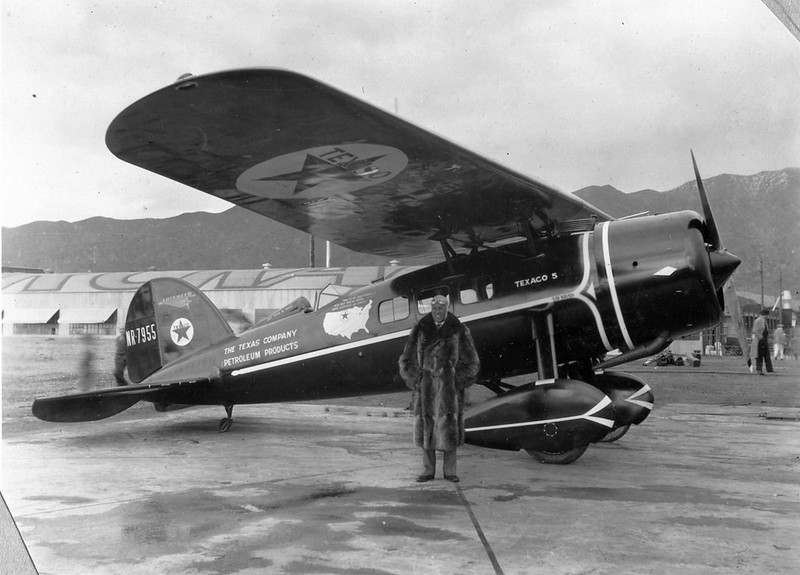
(Source: Flickr)
As a final note, I did come across a claim in a WIX thread that one of the wheel pants for NR3057 still exists.
EDIT (25-11-29): Apparently there is some uncertainty regarding exactly who provided the voice for VIPS in the B-58. At the end of an already interesting post where a man by the name of Eric Urban attempts to clean up copies of the original audio tracks, he suggests there is strong evidence that it was actually a woman named Gina Drazin - and not Joan Elms - that may have read the lines that crews of the mach 2 bomber heard.
Last edited by Noha307 on Sat Nov 29, 2025 12:41 am, edited 1 time in total.
Re: Aircraft Design Firsts
Mon Apr 26, 2021 8:33 pm
I recently picked up a copy of the 1909 to 1971 Racing Planes and Air Races series by Reed Kinert and it includes a few firsts. First of the firsts, is a solution to the confusion over "first airplane with a ducted spinner" that I mentioned in a previous post. The answer comes by way of pushing the date back two years before all the other contestants. In September 1937, the Wittman D-12 Bonzo featured just such an innovation. (Source: Reed Kinert, Racing Planes and Air Races: A Complete History, First, vol. 3, 8 vols. (Fallbrook, California: Aero Publishers, Inc., 1969) 71.)
It apparently started with an earlier version...
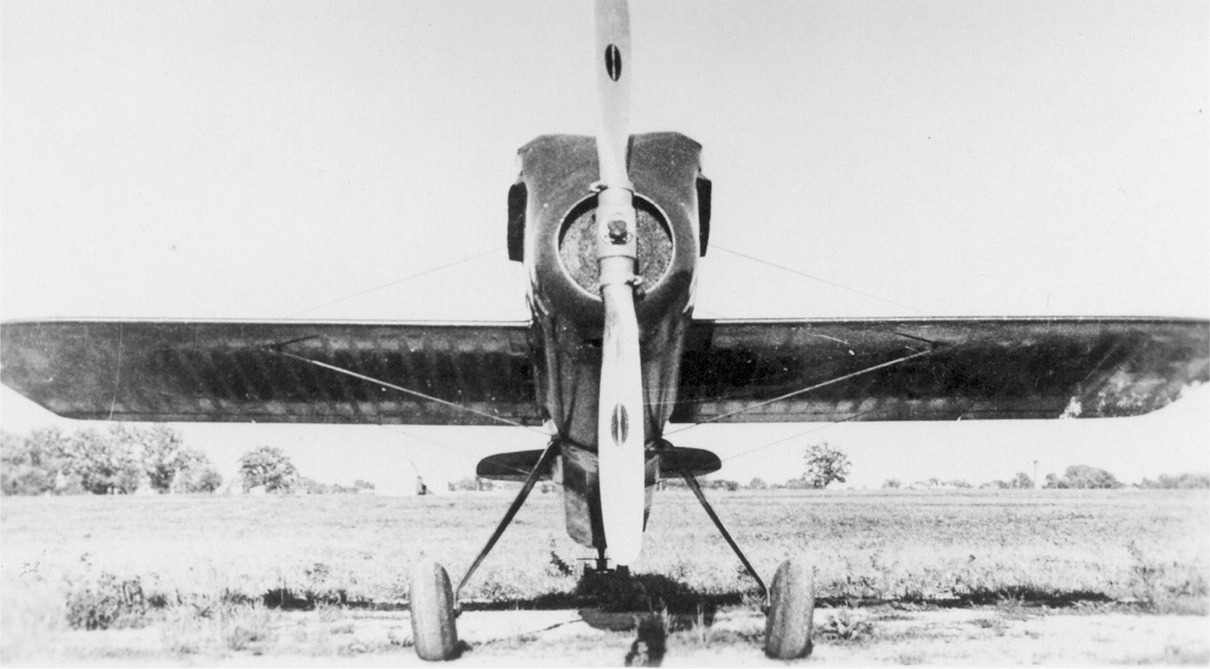
(Source: The Dreamy Dodo)
...that later morphed into the 1937 racer.

(Source: Free Flight Archive)
The book also claims that the Hughes H-1 was "the first aircraft with wing leading edge air intake ducts" and that the "long wing" specifically - as opposed to the shorter "speed wing" - "was the first to have power-driven retractable landing gear". (Source: Reed Kinert, Racing Planes and Air Races: A Complete History, First, vol. 3, 8 vols. (Fallbrook, California: Aero Publishers, Inc., 1969) 75, 77.)

(Source: Wikimedia Commons)
Then, as if perfectly placed to draw a connection between the D-12 and the modified A-17A, Fw 190 V1, and Me 209 V4, it also includes the following interesting claim:
(Source: Reed Kinert, Racing Planes and Air Races: A Complete History, First, vol. 3, 8 vols. (Fallbrook, California: Aero Publishers, Inc., 1969) 87.)
I couldn't find a photo of the Rider R-1 with its gear retracted, so I had to settle for this model blueprint:

(Source: Outerzone)
EDIT (21-04-27): By sheer coincidence, while reading through a different book today, I came across a statement today that was so relevant I just had to include it. It makes the exact counterpoint to the claim about the relevance of air racing to the development of military aircraft:
(Source: S. Paul Johnson, Flying Fleets: A Graphic History of U.S. Naval Aviation (New York: Duell, Sloan and Pearce, 1941), 57-58.)
EDIT (21-10-17): Although it's not clear that it was entirely an intentional feature of the design, the other day I came across an advertisement that pushes the idea of partially extended wheels further back. In 1919, the Martin Aeroplane Factory (apparently unrelated to the company founded by Glenn L. Martin) in Elyria, Ohio was offering "[e]ngineering data and license" for a retractable landing gear system that appeared to result in protruding wheels:
(Source: Aerial Age via Internet Archive)
EDIT: (22-10-01): The other day I came across an example of what I thought was going to be an earlier instance of semi-retractable wheels than the edit above. However, it was only just now, when I went to write this edit, that I realized it was actually the same individual mentioned above! (The source material even includes the same disclaimer about not being confused for the more famous Martin that I did!) Anyway, without further ado, the aircraft was the Martin K-III Kitten, designed by J.V. Martin. It even still exists in the collection of the National Air and Space Museum. Interestingly, the statement in the advertisement above that it should be useable "in any intermediate position between fully extended and fully retracted...in case the pilot should make a hurried descent" seems to confirm the claim that the partially retracted design was an intentional safety feature, and not just an incidental benefit.

(Source: National Air and Space Museum)
EDIT: (25-11-29) It seems that the idea of exposed wheels to protect an aircraft from belly damage was taken to its ultimate conclusion by the Soviets who, as seen in newsreel footage taken at Schipol Airport in 1964, included a second set of (admittedly apparently retractable) centerline landing gear at the rear of the fuselage of the Tu-114 to act as a bumper in the event of a tail strike:
(Source: Wikimedia Commons)
It apparently started with an earlier version...

(Source: The Dreamy Dodo)
...that later morphed into the 1937 racer.

(Source: Free Flight Archive)
The book also claims that the Hughes H-1 was "the first aircraft with wing leading edge air intake ducts" and that the "long wing" specifically - as opposed to the shorter "speed wing" - "was the first to have power-driven retractable landing gear". (Source: Reed Kinert, Racing Planes and Air Races: A Complete History, First, vol. 3, 8 vols. (Fallbrook, California: Aero Publishers, Inc., 1969) 75, 77.)

(Source: Wikimedia Commons)
Then, as if perfectly placed to draw a connection between the D-12 and the modified A-17A, Fw 190 V1, and Me 209 V4, it also includes the following interesting claim:
Reed Kinert wrote:And so ended another great era of air racing, cut short by World War II. During the 1920-1925 race era, commercial aircraft had copied the innovations introduced in military racers, then, after the 1926-29 racing "doldrums," the military designers copied unabashedly from the back-yard-built craft. The Curtiss Hawk model 75, a monoplane built in 1936 and exported to France early in the war, had the exact profile of the earlier Wedell-Williams. Later fitted with retractable gear, the Hawk became the Army P-36, and when fitted with an Allison V-12 engine it became the famous P-40. Designer Keith Rider's racers of 1932 featured a retractable landing gear that left enough of the wheels protruding to allow safe emergency landing. Seversky copied this idea into his P-35 pursuit; Boeing used it on their early 247-D airliners and on the B-17; and Douglas featured it on the famous DC-3.
(Source: Reed Kinert, Racing Planes and Air Races: A Complete History, First, vol. 3, 8 vols. (Fallbrook, California: Aero Publishers, Inc., 1969) 87.)
I couldn't find a photo of the Rider R-1 with its gear retracted, so I had to settle for this model blueprint:

(Source: Outerzone)
EDIT (21-04-27): By sheer coincidence, while reading through a different book today, I came across a statement today that was so relevant I just had to include it. It makes the exact counterpoint to the claim about the relevance of air racing to the development of military aircraft:
S. Paul Johnson wrote:An argument is sometimes advanced that airplane racing, like horse racing, tends to "improve the breed.” Experience has indicated, however, that we get farther faster by depending on well planned, day-in-and-day-out scientific research than by looking for spectacular advances out of racing machines. The Navy came early to this conclusion. Its participation in air racing has been on a modest scale. In 1923 a Navy racer was built by the Curtiss Company for the Schneider Speed Race (an international contest established in 1913, finally abandoned in 1931). That year Lieutenant David Rittenhouse showed his heels to the pack with an average speed of just over 177 miles an hour. There was no contest in 1924, but in the 1925 Schneider Race, America won again. The machine was a Curtiss R-3 seaplane racer. It was flown by James H. Doolittle at an average speed of 232.57 miles per hour. After two straight wins, the U.S. Government officially gave up Schneider racing. It cost too much. The return was too small.
(Source: S. Paul Johnson, Flying Fleets: A Graphic History of U.S. Naval Aviation (New York: Duell, Sloan and Pearce, 1941), 57-58.)
EDIT (21-10-17): Although it's not clear that it was entirely an intentional feature of the design, the other day I came across an advertisement that pushes the idea of partially extended wheels further back. In 1919, the Martin Aeroplane Factory (apparently unrelated to the company founded by Glenn L. Martin) in Elyria, Ohio was offering "[e]ngineering data and license" for a retractable landing gear system that appeared to result in protruding wheels:
(Source: Aerial Age via Internet Archive)
EDIT: (22-10-01): The other day I came across an example of what I thought was going to be an earlier instance of semi-retractable wheels than the edit above. However, it was only just now, when I went to write this edit, that I realized it was actually the same individual mentioned above! (The source material even includes the same disclaimer about not being confused for the more famous Martin that I did!) Anyway, without further ado, the aircraft was the Martin K-III Kitten, designed by J.V. Martin. It even still exists in the collection of the National Air and Space Museum. Interestingly, the statement in the advertisement above that it should be useable "in any intermediate position between fully extended and fully retracted...in case the pilot should make a hurried descent" seems to confirm the claim that the partially retracted design was an intentional safety feature, and not just an incidental benefit.
(Source: National Air and Space Museum)
EDIT: (25-11-29) It seems that the idea of exposed wheels to protect an aircraft from belly damage was taken to its ultimate conclusion by the Soviets who, as seen in newsreel footage taken at Schipol Airport in 1964, included a second set of (admittedly apparently retractable) centerline landing gear at the rear of the fuselage of the Tu-114 to act as a bumper in the event of a tail strike:
(Source: Wikimedia Commons)
Last edited by Noha307 on Sat Nov 29, 2025 12:05 am, edited 4 times in total.
Re: Aircraft Design Firsts
Thu Apr 29, 2021 5:01 pm
The first flying boat to use a stepped hull was apparently either the Curtiss Model E or F. (Although, it's worth noting that not all Model E's had this feature.) The Model F was also the first flying boat to have a V-hull.[1][2]
The bottom of the Ecker flying boat, a homebuilt copy of the Curtiss Model E and F:

(Source: National Air and Space Museum)
Finally, a Model E, serial number A-1, seems to be the first amphibious seaplane:
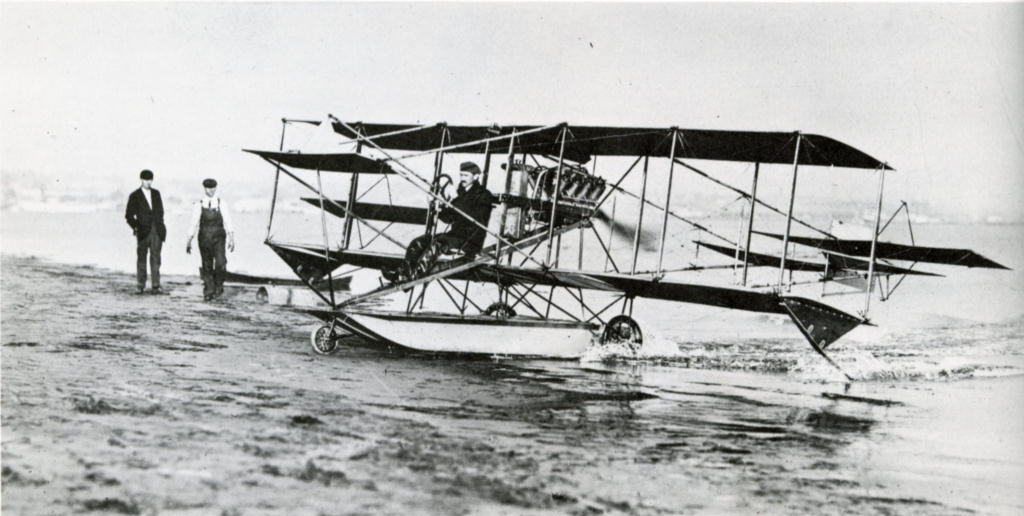
(Source: Wright Brothers Aeroplane Company)
EDIT (22-07-23): Apparent confirmation of the above comes in the form of an annotated picture of of the A-1:
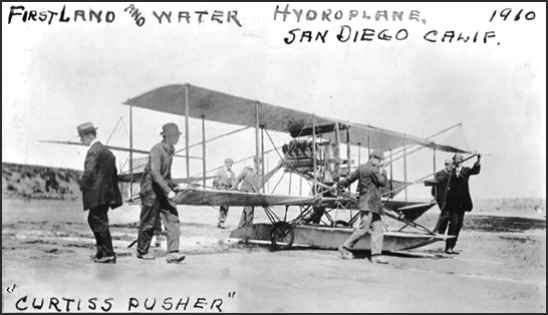
(Source: The Early Birds of Aviation, Inc.)
Interestingly, a handwritten note on the back could contradict the claim of the first aircraft with retractable landing gear made in a previous post.
EDIT (22-11-21): A correction to the above: As a result of recent research by Ian Gee of the Lakes Flying Company the first airplane with either a stepped hull or float was actually the Lakes Waterbird, which was tested on [Lake] Windmere in England on 25 November 1911.[3] Note, however, it could be argued that the Curtiss Model F was the first flying boat with a stepped plaining surface, as the Waterbird was more of a floatplane. (If one distinguishes a hull from a float in that the former requires the crew to sit in, rather than above, it.)
The bottom of the Ecker flying boat, a homebuilt copy of the Curtiss Model E and F:
(Source: National Air and Space Museum)
Finally, a Model E, serial number A-1, seems to be the first amphibious seaplane:

(Source: Wright Brothers Aeroplane Company)
EDIT (22-07-23): Apparent confirmation of the above comes in the form of an annotated picture of of the A-1:

(Source: The Early Birds of Aviation, Inc.)
Interestingly, a handwritten note on the back could contradict the claim of the first aircraft with retractable landing gear made in a previous post.
EDIT (22-11-21): A correction to the above: As a result of recent research by Ian Gee of the Lakes Flying Company the first airplane with either a stepped hull or float was actually the Lakes Waterbird, which was tested on [Lake] Windmere in England on 25 November 1911.[3] Note, however, it could be argued that the Curtiss Model F was the first flying boat with a stepped plaining surface, as the Waterbird was more of a floatplane. (If one distinguishes a hull from a float in that the former requires the crew to sit in, rather than above, it.)
Last edited by Noha307 on Mon Nov 21, 2022 4:51 pm, edited 2 times in total.
Re: Aircraft Design Firsts
Fri Apr 30, 2021 8:29 am
Noha307 wrote:I recently picked up a copy of the 1909 to 1971 Racing Planes and Air Races n-d-12-bonzo-racer]Free Flight Archive[/url])
EDIT (21-04-27): By sheer coincidence, while reading through a different book today, I came across a statement today that was so relevant I just had to include it. It makes the exact counterpoint to the claim about the relevance of air racing to the development of military aircraft:S. Paul Johnson wrote:An argument is sometimes advanced that airplane racing, like horse racing, tends to "improve the breed.” Experience has indicated, however, that we get farther faster by depending on well planned, day-in-and-day-out scientific research than by looking for spectacular advances out of racing machines. The Navy came early to this conclusion. Its participation in air racing has been on a modest scale. In 1923 a Navy racer was built by the Curtiss Company for the Schneider Speed Race (an international contest established in 1913, finally abandoned in 1931). That year Lieutenant David Rittenhouse showed his heels to the pack with an average speed of just over 177 miles an hour. There was no contest in 1924, but in the 1925 Schneider Race, America won again. The machine was a Curtiss R-3 seaplane racer. It was flown by James H. Doolittle at an average speed of 232.57 miles per hour. After two straight wins, the U.S. Government officially gave up Schneider racing. It cost too much. The return was too small.
(Source: S. Paul Johnson, Flying Fleets: A Graphic History of U.S. Naval Aviation (New York: Duell, Sloan and Pearce, 1941), 57-58.)
You could take that quote out of context, but the Schneider Cup definitely had the most influence on military aircraft design around the world. And don't forget that Doolittle convinced the US Government to establish high octane gas development as a necessity of gasoline production for possible wartime use. Other war time powers didn't have that luxury and had to fight engine knock and lower engine compressions with their wartime production engines.
Re: Aircraft Design Firsts
Fri Apr 30, 2021 10:04 am
Noha307 wrote:EDIT (21-04-27): By sheer coincidence, while reading through a different book today, I came across a statement today that was so relevant I just had to include it. It makes the exact counterpoint to the claim about the relevance of air racing to the development of military aircraft:
You could also argue that government money advanced the state of the art more than amateurs could afford to.
Re: Aircraft Design Firsts
Sun May 30, 2021 11:15 pm
The first aircraft with a flight recorder of any sort was the Dyott Monoplane.[1]
Gianni Caproni was apparently an early proponent of aircraft lavatories. According to one reference I found, his Ca.57, Ca.58 and the famous Ca.60 all had toilets.
One I came up with recently was the first helicopter with a five-bladed rotor. I'm not sure what the answer is, but it might be the Sikorsky H-37. The H-37 may also hold another helicopter first: first helicopter with automatic folding rotor blades. It was at least a first for Sikorsky.[2] The first helicopter with folding rotor blades of any kind is also unclear, but the concept goes back to at least the Sikorsky R-5:

(Source: Wikimedia Commons)
Harkening back to a previous post, we have some more propeller weirdness. The first (and possibly only) aircraft with a "variable camber propeller" was the B-17G, 44-85734:
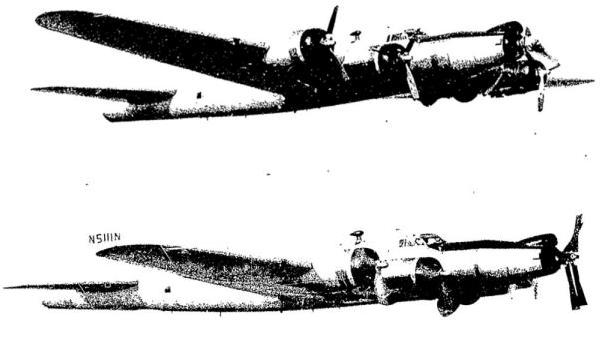
(Source: Aircraft Engine Historical Society)
A rotary propeller may have been first installed on a modified Fokker C.I, PH-APL:
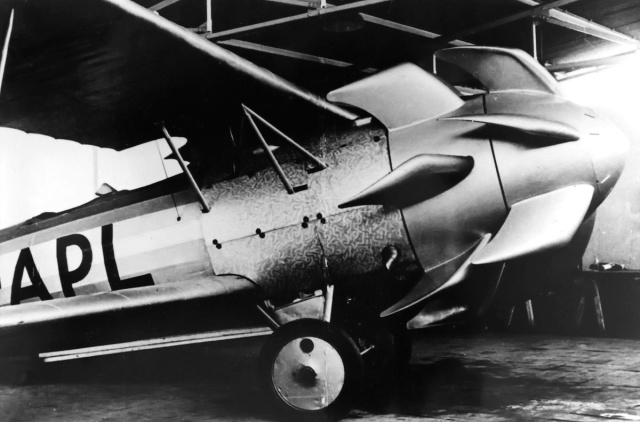
(Source: Old Machine Press)
Finally, a contender for first aircraft with a mid-fuselage mounted propeller is the Gallaudet D-1:

(Source: Their Flying Machines)
EDIT (22-01-23): It turns out the D-1 may not be - depending on your definition of the term - the first aircraft with a mid-fuselage propeller. That dubious honor could belong to the SPAD S.A, which first flew in 1915. (The Royal Aircraft Factory B.E.9 flew later in 1915, but it was of the same configuration as the S.A.) However, one could argue that in both of these aircraft it was less that the propeller was mid-fuselage and more that the gun position was "propeller-forward" as it didn't appear to be an integral part of the structure:

(Source: Twitter)
Gianni Caproni was apparently an early proponent of aircraft lavatories. According to one reference I found, his Ca.57, Ca.58 and the famous Ca.60 all had toilets.
One I came up with recently was the first helicopter with a five-bladed rotor. I'm not sure what the answer is, but it might be the Sikorsky H-37. The H-37 may also hold another helicopter first: first helicopter with automatic folding rotor blades. It was at least a first for Sikorsky.[2] The first helicopter with folding rotor blades of any kind is also unclear, but the concept goes back to at least the Sikorsky R-5:

(Source: Wikimedia Commons)
Harkening back to a previous post, we have some more propeller weirdness. The first (and possibly only) aircraft with a "variable camber propeller" was the B-17G, 44-85734:

(Source: Aircraft Engine Historical Society)
A rotary propeller may have been first installed on a modified Fokker C.I, PH-APL:

(Source: Old Machine Press)
Finally, a contender for first aircraft with a mid-fuselage mounted propeller is the Gallaudet D-1:

(Source: Their Flying Machines)
EDIT (22-01-23): It turns out the D-1 may not be - depending on your definition of the term - the first aircraft with a mid-fuselage propeller. That dubious honor could belong to the SPAD S.A, which first flew in 1915. (The Royal Aircraft Factory B.E.9 flew later in 1915, but it was of the same configuration as the S.A.) However, one could argue that in both of these aircraft it was less that the propeller was mid-fuselage and more that the gun position was "propeller-forward" as it didn't appear to be an integral part of the structure:

(Source: Twitter)
Last edited by Noha307 on Sun Jan 23, 2022 4:04 pm, edited 1 time in total.
Re: Aircraft Design Firsts
Mon Jun 07, 2021 10:32 pm
As mentioned in a previous post, Seversky designs were some of the first with integral wing fuel tanks and I came across an article on page 51 of the February 1935 issue of Aero Digest with a picture of them in the SEV-3XAR.
On a different note, the stick shaker was likely invented by the Safe Flight Instrument Corporation in the late 1940s.[1] (It's worth noting that they initially experimented with a visual and aural warning before moving on to the haptic feedback option.[2]) Therefore, it's likely the first airplane with a stick shaker would have been one that SFIC would have used for testing.
EDIT (21-06-14): Here's the picture from the above Aero Digest article:
(Source: Internet Archive)
EDIT: (22-03-26): The picture in the Aero Digest article appears to have been an edited version of one posted in the Grumman photographs thread:
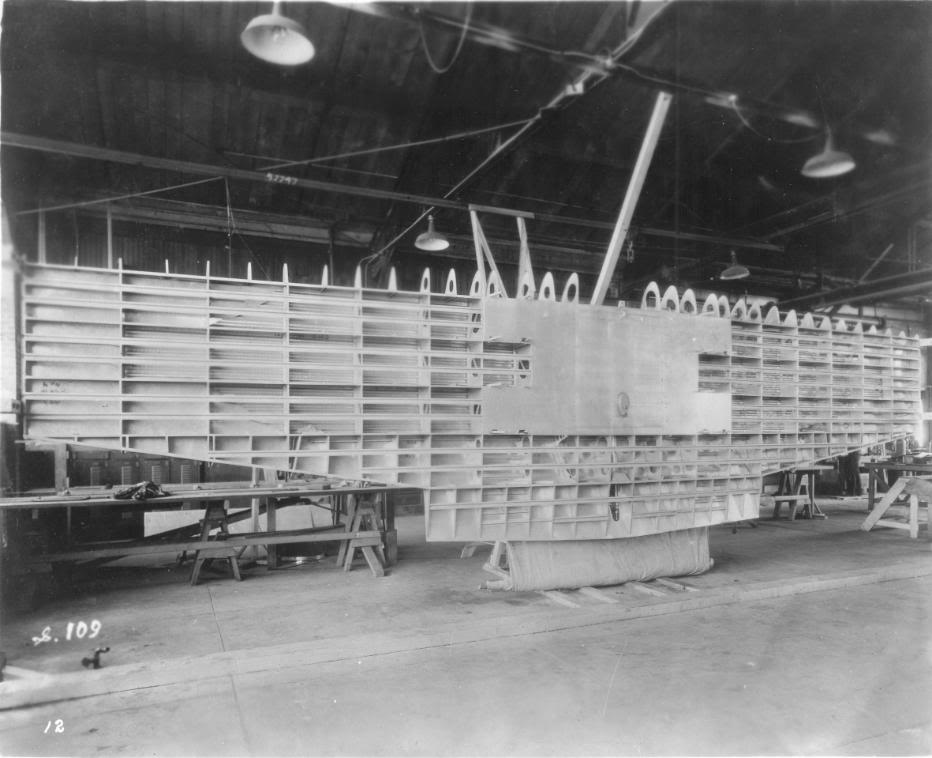
(Source: Warbird Information Exchange)
EDIT (25-11-29): The Consolidated XBY-1, which was tested by the Navy in 1932, reportedly had a wet wing.[3] This would likely predate Seversky's SEV-3XAR.
On a different note, the stick shaker was likely invented by the Safe Flight Instrument Corporation in the late 1940s.[1] (It's worth noting that they initially experimented with a visual and aural warning before moving on to the haptic feedback option.[2]) Therefore, it's likely the first airplane with a stick shaker would have been one that SFIC would have used for testing.
EDIT (21-06-14): Here's the picture from the above Aero Digest article:
(Source: Internet Archive)
EDIT: (22-03-26): The picture in the Aero Digest article appears to have been an edited version of one posted in the Grumman photographs thread:

(Source: Warbird Information Exchange)
EDIT (25-11-29): The Consolidated XBY-1, which was tested by the Navy in 1932, reportedly had a wet wing.[3] This would likely predate Seversky's SEV-3XAR.
Last edited by Noha307 on Sat Nov 29, 2025 12:27 am, edited 3 times in total.
Re: Aircraft Design Firsts
Sun Jun 13, 2021 11:11 pm
The first aircraft with swept propeller blades is unclear. A case history of the High-Speed Propeller Program at NACA notes that it was "reported that the Germans had tested a full-scale propeller with sweptback tips[,] but no data on the results were available".[1] It was likely as part of the former that a P-47 was tested with a swept three-bladed propeller:
(Source: Internet Archive)
There's also an Alexander Eaglerock with a swept propeller at the Wings Over the Rockies Air and Space Museum, but I don't know whether this is original to the aircraft:

(Source: Wikimedia Commons)
EDIT (21-07-04): Based on an advertisement in the March 1930 issue of Aero Digest, the Eaglerock above may have a Paragon brand propeller manufactured by the American Propeller Company:
(Source: Aero Digest via Internet Archive)
(Source: Internet Archive)
There's also an Alexander Eaglerock with a swept propeller at the Wings Over the Rockies Air and Space Museum, but I don't know whether this is original to the aircraft:

(Source: Wikimedia Commons)
EDIT (21-07-04): Based on an advertisement in the March 1930 issue of Aero Digest, the Eaglerock above may have a Paragon brand propeller manufactured by the American Propeller Company:
(Source: Aero Digest via Internet Archive)
Last edited by Noha307 on Sun Jul 04, 2021 3:20 pm, edited 1 time in total.
Re: Aircraft Design Firsts
Mon Jun 21, 2021 7:35 pm
Another design first I came up with recently is the first aircraft with "turkey feathers" (aka afterburner eyelids, aka afterburner petals, aka divergent nozzle external segments, aka variable exhaust nozzle) on its jet engine. So far, the earliest one I have come across is the J57 powered F-100. However, this was an admittedly brief search, so it is entirely possible I missed an older aircraft. If it indeed was the F-100, then the first airframe with turkey feathers would have been the YF-100A, s/n 52-5754:
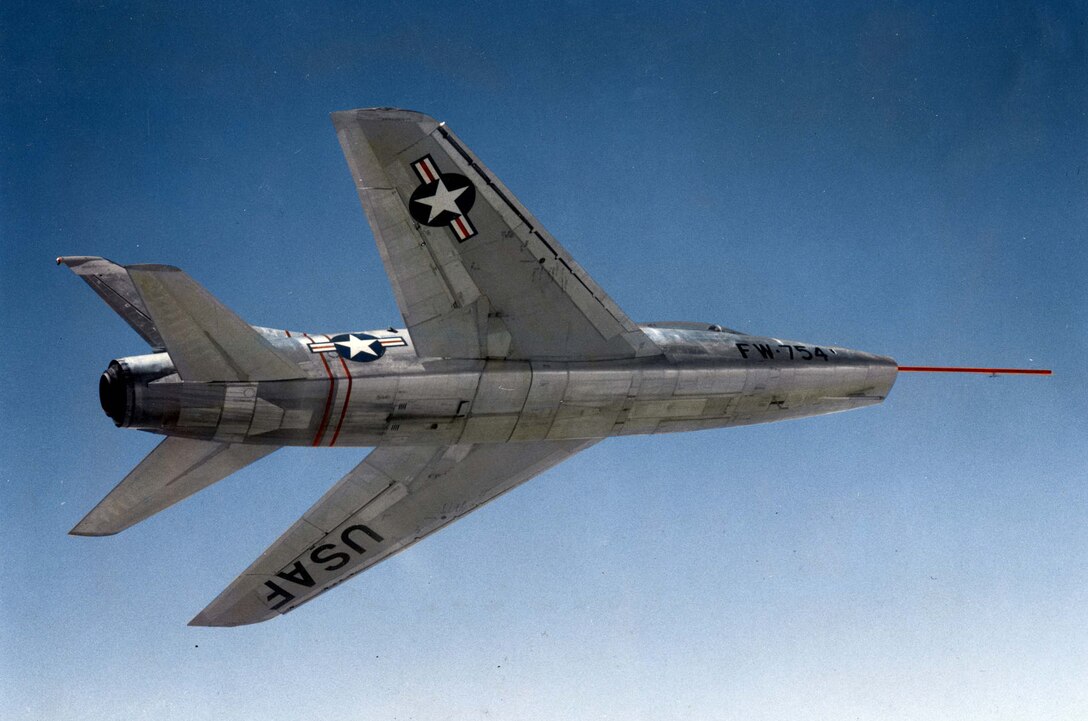
(Source: National Museum of the United States Air Force)
Patents for the concept of using variable petals to constrict of exhaust from jet engines were being submitted as early as 1945:
(Source: United States Patent and Trademark Office)
Corporate names that show up in early patents for this technology include Westinghouse:
(Source: United States Patent and Trademark Office)
and Rolls-Royce:
(Source: United States Patent and Trademark Office)

(Source: National Museum of the United States Air Force)
Patents for the concept of using variable petals to constrict of exhaust from jet engines were being submitted as early as 1945:
(Source: United States Patent and Trademark Office)
Corporate names that show up in early patents for this technology include Westinghouse:
(Source: United States Patent and Trademark Office)
and Rolls-Royce:
(Source: United States Patent and Trademark Office)
Re: Aircraft Design Firsts
Mon Jun 21, 2021 10:30 pm
As noted in a previous post, the Cirrus SF50 is the "first jet aircraft equipped with a whole aircraft parachute". However, it is not the first aircraft of any type with a whole aircraft parachute. That honor likely belongs to a Thunderbird W-14, NX9830, that was owned by Roscoe Turner. The test apparently took place in 1929 and involved a 50' parachute made by the Russell Parachute Company.[1] (It's worth noting that a different source claims performed the stunt in a Lockheed Air Express.[2] It is not clear if this is a mistake or he later repeated the stunt in a different airplane. What is clear is that he did indeed use a W-14 at least once, since the airplane in the picture is clearly a biplane and the caption names it as a "Thunderbird". Both sources state the experiment took place in Santa Ana, California.)
(Source: Chattanooga News via Newspapers.com)
EDIT (21-06-26): It just so happens I came across another early example of the thinking that led to the Cirrus Airframe Parachute System. It even includes mention of a containerized system. This one is from 1946:
(Source: Flying via Google Books)
(Source: Chattanooga News via Newspapers.com)
EDIT (21-06-26): It just so happens I came across another early example of the thinking that led to the Cirrus Airframe Parachute System. It even includes mention of a containerized system. This one is from 1946:
(Source: Flying via Google Books)
Last edited by Noha307 on Sat Jun 26, 2021 9:13 pm, edited 1 time in total.
Re: Aircraft Design Firsts
Wed Jun 23, 2021 8:34 am
Noha
About the female voice water system in the B-58, I have read that the female voice (perhaps being higher pitched?) is more distinct when the listener is task saturated.
The producers of the original Star Trek television series made the computer voice of the USS Enterprise female based on contemporary aircraft. However, the reference I saw mentioned the F-105.
About the female voice water system in the B-58, I have read that the female voice (perhaps being higher pitched?) is more distinct when the listener is task saturated.
The producers of the original Star Trek television series made the computer voice of the USS Enterprise female based on contemporary aircraft. However, the reference I saw mentioned the F-105.
Re: Aircraft Design Firsts
Sat Jun 26, 2021 9:35 pm
JohnB wrote:About the female voice water system in the B-58, I have read that the female voice (perhaps being higher pitched?) is more distinct when the listener is task saturated.
Yeah, I've heard claims like that before. However, I've found that they are hard to substantiate. The Wikipedia article on the subject has a section on it that notes more recent studies have questioned the concept.
I have to wonder whether the decision to use female voices was really driven by good old fashioned sexism rather than any sort of scientific study. Some explanations I've seen are even as simplistic as "men just listen to women". After all, the most common term I've encountered for it is "Bitching Betty". (If that's not enough to drive the imagery of an angry housewife home, it's even apparently called "Nagging Nora" in the UK.)
So, I guess it's entirely possible that there is something about the female voice that makes it more understandable. When I was doing research on the subject for that post I did run into a number of USAF studies on the subject of voice warning systems (e.g. Voice Warning Systems: A Cockpit Improvement that Should Not Be Overlooked), but I didn't bother skimming through them to see if any of them mentioned the aspect of gender. Maybe one of them has an answer. Until then, I remain at least a bit skeptical.
Re: Aircraft Design Firsts
Wed Jul 07, 2021 12:46 am
I don't know if it's technically a first, but something I learned just the other day is that the idea for a retractable windshield, similar to the droop snoot on the Concorde, goes back at least as far as the Republic RC-2 Rainbow:
(Source: Flying via Google Books)
EDIT (21-09-06): I came across another interesting near-postwar windscreen potential configuration illustration. It was interesting to learn that Lockheed was considering using the dual "bug-eye" design for the Constellation, as prior to this I thought that idea was isolated to the C-74 and XB-42/XB-43:
(Source: Aviation News via Internet Archive)
(Source: Flying via Google Books)
EDIT (21-09-06): I came across another interesting near-postwar windscreen potential configuration illustration. It was interesting to learn that Lockheed was considering using the dual "bug-eye" design for the Constellation, as prior to this I thought that idea was isolated to the C-74 and XB-42/XB-43:
Aviation News wrote:CONSTELLATION WINDSHIELD DESIGNS:
These sketches represent an engineering problem in connection with
the design of Lockheed's Constellation. Maximum visibility and min-
imum drag were prime considerations in research on cockpit windshield
proposals for the plane. Types I to V indicated maximum streamlining,
but Type VI was chosen. Engineers found little drag difference be-
tween it and other shapes and visibility excellent.
(Source: Aviation News via Internet Archive)
Last edited by Noha307 on Mon Sep 06, 2021 8:58 pm, edited 2 times in total.
Re: Aircraft Design Firsts
Wed Jul 07, 2021 8:45 am
I'm not sure you can compare the Rainbow, which I've never heard of, and Concorde because they're for completely different situations.
The Concorde droop snoot, originally designed by and licenced from Fairey Aviation, was devised because they realised that the high angle of attack of a delta aircraft meant it would be impossible to see the runway when landing.
See the Fairey Delta 2 or FD2 - the aircraft that absolutely demolished the world air speed record. The two built still survive but it's always infuriated me that the actual record holder was converted into the BAC.221 for aerodynamic research for the Concorde ogee wing.
Concorde did have a retractable screen/shield too, but I believe that was for air resistance and heat reasons.
The Concorde droop snoot, originally designed by and licenced from Fairey Aviation, was devised because they realised that the high angle of attack of a delta aircraft meant it would be impossible to see the runway when landing.
See the Fairey Delta 2 or FD2 - the aircraft that absolutely demolished the world air speed record. The two built still survive but it's always infuriated me that the actual record holder was converted into the BAC.221 for aerodynamic research for the Concorde ogee wing.
Concorde did have a retractable screen/shield too, but I believe that was for air resistance and heat reasons.
Re: Aircraft Design Firsts
Thu Jul 08, 2021 5:27 pm
dhfan wrote:I'm not sure you can compare the Rainbow, which I've never heard of, and Concorde because they're for completely different situations.
Okay, first off, if you've never heard of the Rainbow you're missing out on one slick airplane:
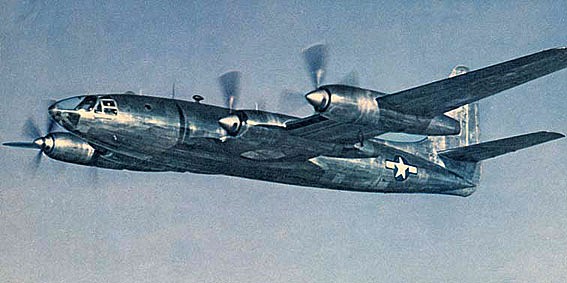
(Source: Wikimedia Commons)
It's unfortunate they never built more than two military prototypes and neither survived. (So I guess I can sympathize with your note about the FD2.)
However, you're very correct about the differing purposes of the movable windscreen. It's also worth noting that, as far as I can tell, only the windscreen on the RC-2 that was intended to move - not the entire nose like on the Concorde. My point was less of an exact comparison and more that the concept of some sort of movable nose goes back at least that far.
dhfan wrote:The Concorde droop snoot, originally designed by and licenced from Fairey Aviation, was devised because they realised that the high angle of attack of a delta aircraft meant it would be impossible to see the runway when landing.
See the Fairey Delta 2 or FD2 - the aircraft that absolutely demolished the world air speed record. The two built still survive but it's always infuriated me that the actual record holder was converted into the BAC.221 for aerodynamic research for the Concorde ogee wing.
I wasn't aware of the Fairey Delta 2 (or rather I feel like I had seen it before, but either forgot about it or never realized that it had the droop snoot) - thanks for mentioning it. It definitely seems like the first aircraft with an entirely moveable nose. In any event, I don't think either of the XF-12s were ever modified to RC-2 configuration, so the RC-2 being first is kind of a moot point since it never existed!
dhfan wrote:Concorde did have a retractable screen/shield too, but I believe that was for air resistance and heat reasons.
This actually makes me wonder how a retractable windscreen was intended to help the RC-2 with "bad weather landings". Maybe it was supposed to reduce glare like the forward slanted windscreen on the Boeing 247?